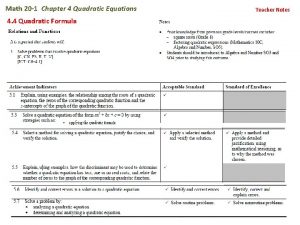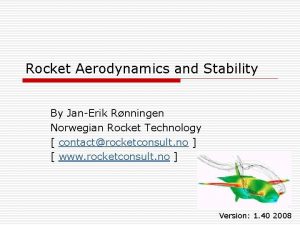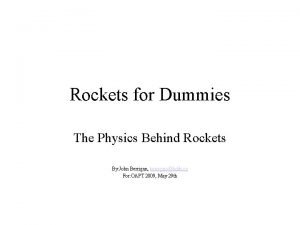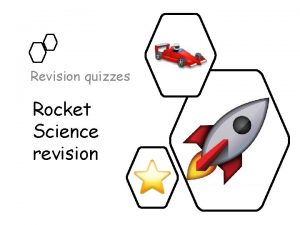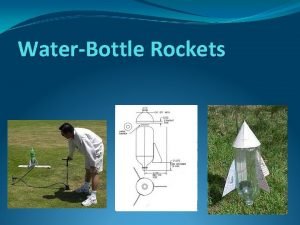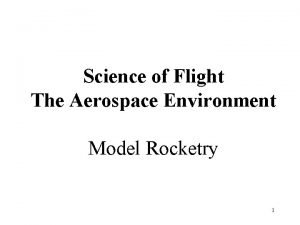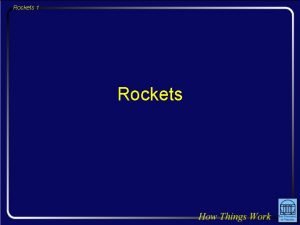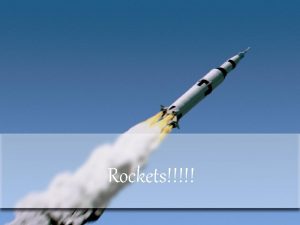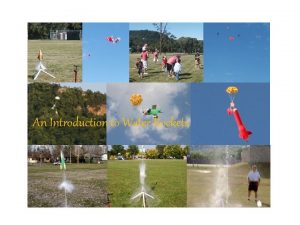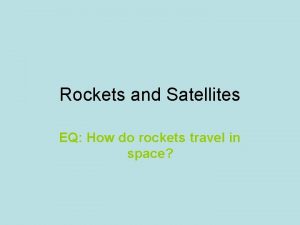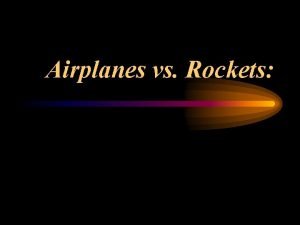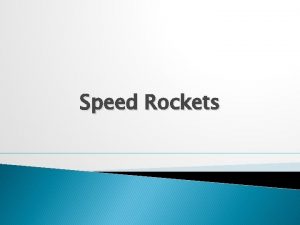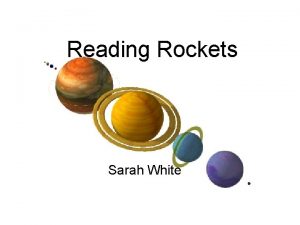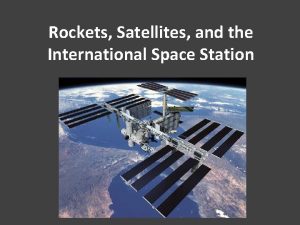Rockets 1 Rockets Rockets 2 Question If there
















- Slides: 16

Rockets 1 Rockets

Rockets 2 Question: If there were no launch pad beneath the space shuttle at lift-off, the upward thrust of its engines would be • approximately unchanged. • approximately half as much. • approximately zero.

Rockets 3 Observations About Rockets • • • Plumes of flame emerge from rockets Rockets can accelerate straight up Rockets can go very fast The flame only touches the ground initially Rockets operate well in empty space Rockets usually fly nose-first

Rockets 4 Momentum Conservation • A rocket’s momentum is initially zero • Momentum is redistributed during thrust – Ship pushes on fuel; fuel pushes on ship – Fuel acquires backward momentum – Ship acquires forward momentum • Rocket’s total momentum remains zero

Rockets 5 Rocket Propulsion • Neglecting gravity, then – rocket’s total momentum is always zero • The momentum of the ship is opposite • the momentum of the ejected fuel – or, equivalently, • the velocity of that fuel and • the mass of that fuel

Rockets 6 Question: If there were no launch pad beneath the space shuttle at lift-off, the upward thrust of its engines would be • approximately unchanged. • approximately half as much. • approximately zero.

Rockets 7 Rocket Engines • Chemical reactions produce hot, highpressure gas • Gas speeds up in nozzle • Gas reaches sonic speed in throat of de Laval nozzle • Beyond throat, supersonic gas expands to speed up further

Rockets 8 Stability and Orientation • On ground, rocket needs static stability • In air, rocket needs aerodynamic stability – Center of dynamic pressure behind c. o. m. • In space, rocket is a freely rotating object – Orientation governed by angular momentum – Rocket’s orientation doesn’t affect its travel

Rockets 9 Ship’s Ultimate Speed • Increases as – ratio of fuel mass to ship mass increases – fuel exhaust speed increases • If fuel were released with rocket at rest, • Because rocket accelerates during thrust, ultimate speed is less than given above

Rockets 10 Gravity, Part 1 • The earth’s acceleration due to gravity is only constant for small changes in height • When the distance between two objects changes substantially, the relationship is:

Rockets 11 Gravity, Part 2 • An object’s weight is only constant for small changes in height • When its height changes significantly, the relationship is:

Rockets 12 Gravity, Part 3 • Even far above earth, an object has weight • Astronauts and satellites have weights – weights are somewhat less than normal – weights depend on altitude • Astronauts and satellites are in free fall

Rockets 13 Orbits, Part 1 • An object that begins to fall from rest falls directly toward the earth • Acceleration and velocity are in the same direction

Rockets 14 Orbits, Part 2 • An object that has a sideways velocity follows a trajectory called an orbit • Orbits can be closed or open, and are ellipses, parabolas, and hyperbolas

Rockets 15 Current Rocket Technology • X-Prize Rockets • Single State to Orbit Rockets • Improbable Dreams – Rockets that rarely require refueling – Rockets that can land leave large planets – Rockets that can turn on a dime in space

Rockets 16 Summary About Rockets • Rockets are pushed forward by their fuel • Total rocket impulse is the product of exhaust speed times exhaust mass • Rockets can be stabilized aerodynamical • Rockets can be stabilized by thrust alone • After engine burn-out, rockets can orbit
 Costa level questions science
Costa level questions science Brief history of rockets
Brief history of rockets Johnny rockets fresno
Johnny rockets fresno Application of quadratic equation
Application of quadratic equation Rocket aerodynamics
Rocket aerodynamics Thrust formula
Thrust formula Rocket science quiz
Rocket science quiz Red rockets and rainbow jelly
Red rockets and rainbow jelly Tree rockets
Tree rockets Water bottle rocket designs
Water bottle rocket designs Roaring rockets powerpoint
Roaring rockets powerpoint Newtons 3 laws
Newtons 3 laws Model rockets
Model rockets Newton's third law rockets
Newton's third law rockets Direct and indirect questions with answers
Direct and indirect questions with answers Closed question and open question
Closed question and open question Present simple question words
Present simple question words



